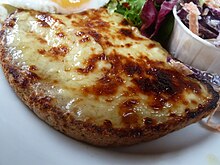
A sandwich is a food typically consisting of vegetables, sliced cheese or meat, placed on or between slices of bread, or more generally any dish wherein bread serves as a container or wrapper for another food type. The sandwich began as a portable, convenient finger food in the Western world, though over time it has become prevalent worldwide.
An hors d'oeuvre, appetiser or starter is a small dish served before a meal in European cuisine. Some hors d'oeuvres are served cold, others hot. Hors d'oeuvres may be served at the dinner table as a part of the meal, or they may be served before seating, such as at a reception or cocktail party. Formerly, hors d'oeuvres were also served between courses. There are two types of hors d'oeuvre from service point of view:
- General hors d'oeuvre
- Classical hors d'oeuvre

Hungarian or Magyar cuisine is the cuisine characteristic of the nation of Hungary, and its primary ethnic group, the Magyars. Hungarian cuisine has been described as being the spiciest cuisine in Europe. This can largely be attributed to the use of their piquant native spice, Hungarian paprika, in many of their dishes. A mild version of the spice, Hungarian sweet paprika, is commonly used as an alternative. Traditional Hungarian dishes are primarily based on meats, seasonal vegetables, fruits, bread, and dairy products.

Pigs in a blanket in the United States is a small hot dog or other sausage wrapped in pastry similar to a sausage roll in the UK, it is commonly served as an appetizer in the United States. The similarity in name with that of the UK dish pigs in blankets, which is a sausage wrapped in bacon, sometimes causes confusion.

Welsh rarebit or Welsh rabbit is a dish of hot cheese sauce served on toasted bread. The original 18th-century name of the dish was the jocular "Welsh rabbit", which was later reinterpreted as "rarebit", as the dish contains no rabbit. Variants include English rabbit, Scotch rabbit, buck rabbit, golden buck, and blushing bunny.

An open sandwich, also known as an open-face/open-faced sandwich, bread baser, bread platter or tartine, consists of a slice of bread or toast with one or more food items on top. It has half the amount of bread of a typical closed sandwich.

A canapé is a type of starter, a small, prepared, and often decorative food, consisting of a small piece of bread or cracker, wrapped or topped with some savoury food, held in the fingers and often eaten in one bite.

Queen of Puddings is a traditional British dessert, consisting of a baked, breadcrumb-thickened egg mixture, spread with jam and topped with meringue. Similar recipes are called Monmouth Pudding and Manchester Pudding.

Czech cuisine has both influenced and been influenced by the cuisines of surrounding countries and nations. Many of the cakes and pastries that are popular in Central Europe originated within the Czech lands. Contemporary Czech cuisine is more meat-based than in previous periods; the current abundance of farmable meat has enriched its presence in regional cuisine. Traditionally, meat has been reserved for once-weekly consumption, typically on weekends.

A zapiekanka is a toasted open-face sandwich made of a sliced baguette or other long roll of bread, topped with sautéed white mushrooms, cheese and sometimes other ingredients such as ham. Served hot with ketchup, it has been a popular street food in Poland since the 1970s.

Devils on horseback are a hot appetizer or small savoury dish of dried fruit stuffed with such ingredients as cheese or nuts, wrapped in bacon, prosciutto or pancetta. The traditional form of the dish is made with a pitted date and bacon, but prunes are also used, usually steeped in brandy or some other liqueur. These are then fried or baked in the oven and quite often served on toast, with chutney and mustard.

Angels on horseback is a hot hors d'œuvre or savoury made of oysters wrapped with bacon. The dish, when served atop breads, can also be a canapé.

The Closet of the Eminently Learned Sir Kenelme Digbie Kt. Opened, commonly known as The Closet Opened, is an English cookery book first printed in 1669. The title page states that it is based upon the writings of Sir Kenelm Digby, "published by his son's consent".

Bacon-wrapped foods are foods that are prepared by being covered in bacon. They may be baked, fried, or grilled. Popular bacon-wrapped dishes include angels on horseback, devils on horseback, and pigs in blankets. Bacon has long been used for barding roasts, especially game birds.
Breakfast, the first meal of the day eaten after waking from the night's sleep, varies in composition and tradition across the world.














